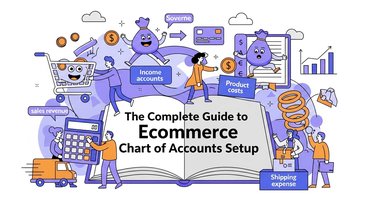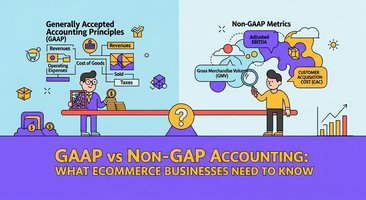Selling across multiple marketplaces like Amazon, eBay, Etsy, and others can significantly boost your revenue, but it also creates a complex web of fees that can quickly eat into your profits if not properly tracked and managed.
Each platform has its own unique fee structure, from Amazon's FBA fulfillment fees to eBay's final value fees, from Etsy's transaction fees to Walmart's referral fees. Without proper marketplace fee accounting, you could be unknowingly losing thousands of dollars annually to hidden costs, miscategorized expenses, and inaccurate profit calculations.
This comprehensive guide will help you understand, track, and optimize marketplace fees across all major selling platforms, ensuring your business maintains healthy profit margins and accurate financial records.
Understanding Different Types of Marketplace Fees
Amazon Fee Structure
Amazon operates one of the most complex fee structures in ecommerce, with multiple fee types that vary based on your selling method, product category, and fulfillment choice.
Subscription Fees
- Individual Plan: $0.99 per item sold
- Professional Plan: $39.99 per month
Referral Fees
Amazon charges referral fees ranging from 8% to 15% of the total sale price, depending on the product category. Some categories like Amazon Device Accessories can go as high as 45%.
FBA Fees (Fulfillment by Amazon)
FBA fees are calculated based on product size and weight tiers:
- Small standard items: $3.22 - $3.65
- Large standard items: $4.99 - $6.92+ (depending on weight)
- Oversize items: $9.61+ (with additional per-pound charges)
Storage Fees
- Standard size: $0.87 per cubic foot (Jan-Sep), $2.40 per cubic foot (Oct-Dec)
- Oversize: $0.56 per cubic foot (Jan-Sep), $1.40 per cubic foot (Oct-Dec)
Additional Amazon Fees
- Long-term storage fees for inventory over 365 days
- Removal and disposal fees
- Return processing fees
- Advertising fees (PPC campaigns)
eBay Fee Structure
eBay's fee structure has evolved significantly with their managed payments system, consolidating multiple fee types into streamlined categories.
Insertion Fees (Listing Fees)
- Free listings: 250 per month for most categories
- Additional listings: $0.35 per listing
- Store subscribers get more free listings based on subscription level
Final Value Fees
eBay charges final value fees as a percentage of the total sale amount (including shipping):
- Most categories: 12.9% of sale price
- Books, DVDs, Movies, Music: 12% of sale price
- Managed payments fee is included in final value fees
Store Subscription Fees
- Starter Store: $7.95/month
- Basic Store: $27.95/month
- Premium Store: $74.95/month
- Anchor Store: $349.95/month
- Enterprise Store: $2,999.95/month
Optional Upgrade Fees
- Bold listing: $2-$4
- Subtitle: $1.50
- Gallery Plus: $1.25
- Listing Designer: $0.10
Etsy Fee Structure
Etsy maintains a relatively straightforward fee structure focused on listing fees, transaction fees, and payment processing.
Listing Fees
- $0.20 per item listed
- Listings auto-renew every 4 months or when sold
Transaction Fees
- 6.5% of the item price
- Includes shipping costs and gift wrapping charges
Payment Processing Fees
- 3% + $0.25 per transaction for US sellers
- Varies by country for international sellers
Advertising Fees
- Etsy Ads: Variable cost-per-click
- Offsite Ads: 12% fee (can't be turned off for sellers with $10,000+ annual revenue)
Additional Services
- Pattern (website builder): $15/month
- Plus subscription: $10/month
Other Major Marketplaces
Walmart Marketplace
- Referral fees: 6% to 20% depending on category
- No monthly subscription fees
- No listing fees for approved sellers
Facebook/Instagram Shopping
- 5% selling fee or 2.9% + $0.30 with checkout on your website
- No listing fees
Google Shopping
- Free listings available
- Google Ads charges apply for promoted listings
TikTok Shop
- 0% commission through 2024 (promotional period)
- Standard rates will apply after promotional period ends
The Challenge of Multi-Platform Fee Management
Different Fee Structures Create Complexity
Each marketplace calculates fees differently, making it challenging to compare true profitability across platforms. Amazon might have higher upfront fees but better conversion rates, while eBay might have lower listing costs but higher final value fees.
Timing Discrepancies
Marketplaces charge and collect fees at different times:
- Some charge upfront (listing fees)
- Others charge after sale completion (final value fees)
- Some deduct from payouts automatically
- Others charge credit cards on file
Currency and Payment Processing Variations
Different platforms use various payment processors, each with their own fee structures and currency conversion rates, adding another layer of complexity to fee tracking.
Hidden Costs and Fee Changes
Marketplaces frequently update their fee structures, and some costs aren't immediately obvious, such as:
- Storage fees for unsold inventory
- Return processing fees
- Advertising fees that auto-renew
- Currency conversion fees
- Chargeback fees
Proper Accounting Methods for Marketplace Fees
Chart of Accounts Setup
Create specific accounts for each type of marketplace fee to maintain clear visibility:
Amazon Fees:
- Amazon - Referral Fees
- Amazon - FBA Fulfillment Fees
- Amazon - Storage Fees
- Amazon - Advertising Fees
- Amazon - Subscription Fees
eBay Fees:
- eBay - Final Value Fees
- eBay - Insertion Fees
- eBay - Store Subscription Fees
- eBay - Promotional Fees
Etsy Fees:
- Etsy - Transaction Fees
- Etsy - Listing Fees
- Etsy - Payment Processing Fees
- Etsy - Advertising Fees
Accrual vs. Cash Accounting
Accrual Accounting (Recommended)Record fees when they're incurred, regardless of when they're actually paid. This provides a more accurate picture of profitability by matching fees with the sales they relate to.Cash AccountingRecord fees only when they're actually paid. This is simpler but can distort profitability analysis, especially when fees are deducted from future payouts.
Revenue Recognition Best Practices
When recording marketplace sales, separate the gross sale amount from the fees:Correct Method:
- Debit: Accounts Receivable $100
- Credit: Sales Revenue $100
- Debit: Marketplace Fees $15
- Credit: Accounts Receivable $15
Incorrect Method:
- Debit: Cash $85
- Credit: Sales Revenue $85
The correct method shows your true gross revenue and allows for proper fee analysis.
Automated Solutions for Marketplace Fee Tracking
The Problem with Manual Tracking
Manual fee tracking across multiple marketplaces is:
- Time-consuming and error-prone
- Difficult to scale as your business grows
- Prone to missed fees and categorization errors
- Challenging for real-time profitability analysis
Benefits of Automated Fee Tracking
Real-Time Accuracy
Automated systems capture every fee as it occurs, ensuring nothing is missed or miscategorized.
Multi-Platform Consolidation
View all marketplace fees in one dashboard, making it easy to compare profitability across channels.
Detailed Reporting
Generate reports showing fee trends, platform comparisons, and profitability analysis by product or category.
Integration with Accounting Software
Fees are automatically categorized and recorded in your accounting system, saving hours of manual data entry.
How Klavena Simplifies Marketplace Fee Accounting
Klavena's advanced marketplace fee tracking system addresses the unique challenges of multi-platform selling:
Comprehensive Platform Coverage
Klavena integrates with all major marketplaces including Amazon, eBay, Etsy, Walmart, Shopify, and more, providing unified fee tracking across your entire business.
Intelligent Fee Categorization
The system automatically identifies and categorizes different fee types:
- Referral and commission fees
- Fulfillment and shipping fees
- Storage and inventory fees
- Advertising and promotional fees
- Payment processing fees
- Subscription and service fees
Real-Time Fee Monitoring
Track fees as they occur with real-time updates, allowing you to:
- Monitor fee trends across platforms
- Identify unexpected fee increases
- Optimize your selling strategy based on true costs
Advanced Reporting and Analytics
Generate detailed reports showing:
- Fee breakdown by marketplace
- Profitability analysis by platform
- Fee trends over time
- Cost per acquisition by channel
- ROI analysis for each marketplace
Seamless QuickBooks Integration
Klavena automatically syncs all marketplace fees to your QuickBooks account with proper categorization:
- Creates separate accounts for each fee type
- Maintains detailed transaction records
- Provides audit trails for all fee entries
- Supports both cash and accrual accounting methods
Fee Optimization Strategies by Platform
Amazon Fee Optimization
Product Sizing and Packaging
Optimize product dimensions and weight to move into lower FBA fee tiers. Even small reductions can significantly impact fees for high-volume products.
Inventory Management
Avoid long-term storage fees by:
- Monitoring inventory age reports
- Creating removal orders for slow-moving stock
- Using promotions to clear aged inventory
Fulfillment Strategy
Compare FBA vs. FBM costs for each product:
- High-volume, lightweight items often benefit from FBA
- Large, heavy, or slow-moving items might be more profitable with FBM
Advertising Optimization
Regularly review and optimize PPC campaigns:
- Focus on high-converting keywords
- Use negative keywords to reduce wasted spend
- Monitor ACoS (Advertising Cost of Sales) targets
eBay Fee Optimization
Store Subscription Analysis
Calculate whether a store subscription saves money based on your listing volume:
- Basic Store subscribers get 250 free listings per month
- Higher tiers offer reduced final value fees
Listing Optimization
- Use free listing allowances strategically
- Avoid unnecessary listing upgrades unless they significantly increase sales
- Consider auction-style listings for unique items to potentially reduce final value fees
Shipping Strategy
Optimize shipping costs as they're included in final value fee calculations:
- Use eBay's managed shipping for discounted rates
- Consider free shipping with higher item prices
Etsy Fee Optimization
Listing Strategy
- Focus on high-quality listings that convert well to maximize the value of listing fees
- Use all 13 available tags to improve visibility
- Optimize titles for Etsy's search algorithm
Photography and SEO
Invest in quality product photos and SEO optimization to improve conversion rates and justify the 6.5% transaction fee.
Advertising Management
- Carefully monitor Etsy Ads performance
- Be strategic about Offsite Ads eligibility (automatically enrolled at $10k+ annual sales)
Common Marketplace Fee Accounting Mistakes
Mistake 1: Recording Net Revenue Instead of Gross
Many sellers record only the net amount received after fees, which understates revenue and makes fee analysis impossible.Impact: Inaccurate financial statements, difficulty analyzing true profitability, and potential tax compliance issues.
Mistake 2: Inconsistent Fee Categorization
Using different account names or categories for similar fees across platforms makes comparative analysis difficult.
Impact: Inability to compare platform profitability, difficulty identifying fee trends, and poor decision-making data.
Mistake 3: Ignoring Timing Differences
Not accounting for when fees are incurred vs. when they're charged can distort monthly profitability analysis.
Impact: Inaccurate period-specific profitability, poor cash flow forecasting, and misleading financial reports.
Mistake 4: Missing Hidden Fees
Overlooking less obvious fees like storage costs, return processing fees, or currency conversion charges.Impact: Understated costs, inflated profit margins, and inaccurate pricing decisions.
Mistake 5: Manual Tracking Errors
Relying on manual data entry for fee tracking across multiple platforms leads to errors and omissions.Impact: Inaccurate financial records, missed deductions, and time wasted on corrections.
Advanced Fee Analysis and Reporting
Key Performance Indicators (KPIs)
Fee-to-Revenue Ratio
Calculate the percentage of revenue consumed by marketplace fees for each platform:
Fee-to-Revenue Ratio = Total Fees ÷ Gross Revenue × 100
Platform Profitability Analysis
Compare net profitability after all fees across different marketplaces:
Net Profit Margin = (Revenue - COGS - Fees) ÷ Revenue × 100
Fee Trend Analysis
Track fee changes over time to identify:
- Platform fee increases
- Seasonal fee variations
- Opportunities for optimization
Custom Reporting Solutions
Monthly Fee Summary ReportsGenerate reports showing:
- Total fees by platform
- Fee breakdown by category
- Month-over-month fee changes
- Fee impact on profitability
Product-Level Fee AnalysisAnalyze fees at the individual product level to:
- Identify high-fee products
- Optimize pricing strategies
- Make informed inventory decisions
Platform Comparison ReportsCompare key metrics across platforms:
- Average fee percentage by platform
- Profitability after fees
- Volume vs. profitability analysis
Tax Implications of Marketplace Fees
Deductible Business Expenses
All legitimate marketplace fees are generally deductible as business expenses, including:
- Referral and commission fees
- Listing and insertion fees
- Fulfillment and shipping fees
- Storage and inventory fees
- Advertising and promotional fees
- Payment processing fees
Proper Documentation Requirements
Maintain detailed records of all marketplace fees:
- Date and amount of each fee
- Description of the fee type
- Platform that charged the fee
- Related transaction or listing ID
- Business purpose of the expense
1099-K Reporting Considerations
When receiving 1099-K forms from marketplaces, remember that the reported gross amount includes fees that you can deduct as business expenses. Proper fee tracking ensures you don't overpay taxes on fee amounts.
Best Practices for Marketplace Fee Management
1. Implement Automated Tracking
Use automated solutions like Klavena to ensure every fee is captured and properly categorized without manual intervention.
2. Regular Fee Audits
Conduct monthly reviews of marketplace fees to:
- Identify any unusual charges
- Verify fee calculations
- Spot opportunities for optimization
3. Platform Performance Analysis
Regularly analyze the total cost of selling on each platform, including:
- All fee types
- Time investment required
- Conversion rates and sales velocity
- Customer acquisition costs
4. Fee Budgeting and Forecasting
Include marketplace fees in your business budgeting:
- Forecast fees based on sales projections
- Plan for seasonal fee variations
- Budget for platform fee increases
5. Stay Informed About Fee Changes
Subscribe to platform updates and regularly review fee structures as they change frequently and can significantly impact profitability.
Conclusion: Mastering Marketplace Fee Accounting for Business Success
Effective marketplace fee accounting is crucial for maintaining profitable multi-channel ecommerce operations. With the complexity of modern marketplace fee structures, manual tracking is no longer viable for growing businesses.
The key to success lies in implementing automated solutions that can handle the intricacies of multi-platform fee tracking while providing the detailed insights needed for strategic decision-making.
Klavena's comprehensive marketplace fee accounting solution eliminates the complexity of manual fee tracking while providing the detailed insights needed to optimize your multi-channel selling strategy. With automated fee categorization, real-time monitoring, and seamless QuickBooks integration, you can focus on growing your business while maintaining perfect financial records.
Don't let marketplace fees eat into your profits. Take control of your marketplace fee accounting today and ensure every dollar is properly tracked, categorized, and optimized for maximum profitability.
Ready to streamline your marketplace fee accounting? Discover how Klavena can automate your multi-channel bookkeeping and provide the insights you need to maximize profitability across all your selling platforms.





